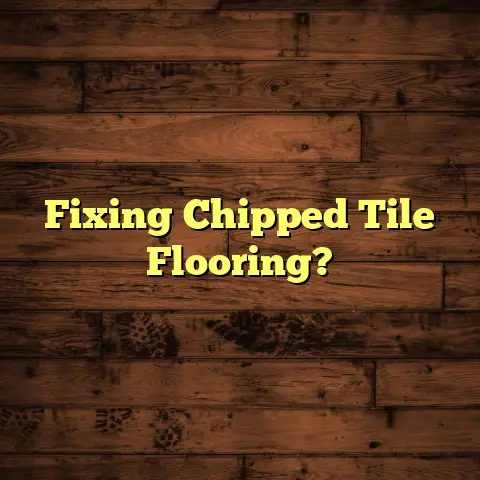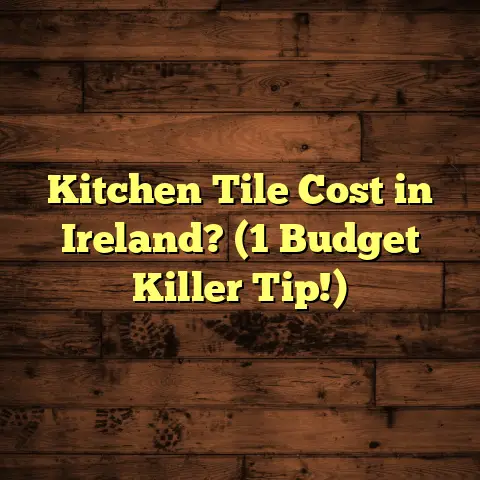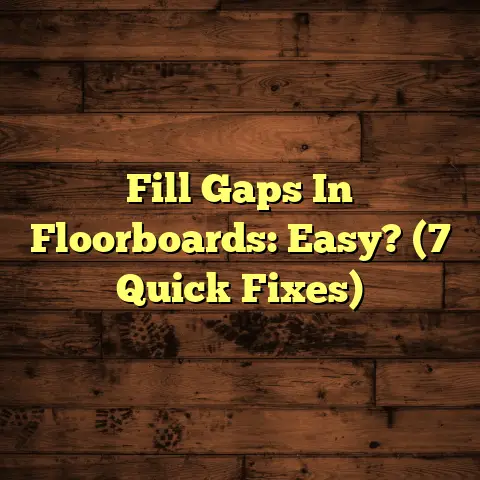How To Stop Shoes Squeaking On Floors? (Explained)
I often hear from friends and clients about the annoyance of shoes squeaking on floors.
It’s a pesky problem that can disrupt the peace of even the coziest home.
I’ve dealt with this issue time and again, both in my professional projects and personal life.
Today, I want to share my insights on how to tackle this problem effectively.
Why Shoes Squeak on Floors
Squeaking shoes can come from various sources.
Most commonly, it’s due to friction between the shoe sole and the flooring material.
But other factors can contribute, such as moisture, dirt, or even the construction of the shoe itself.
Have you ever noticed how some shoes are more prone to squeaking than others?
It’s all in the design!
The Anatomy of a Shoe
Understanding why shoes squeak means taking a closer look at their anatomy.
Here are the main components that can contribute to noise:
- Sole: The part of the shoe that makes contact with the floor.
Different materials (rubber, leather, etc.) react differently with various flooring types. - Insole: The inner part of the shoe that provides comfort and support.
A poorly fitted insole can cause movement and friction, leading to squeaks. - Upper: The part of the shoe that covers the foot.
Materials and construction methods can affect how sound is transmitted.
I remember a project where I installed laminate flooring in a client’s home.
After the installation, they mentioned how their new shoes squeaked loudly on the floor.
We quickly figured out that it wasn’t just the flooring; it was also the shoe materials that contributed to the sound.
Identifying the Problem
To solve the squeaking issue, we first need to identify its source.
Here are some steps I recommend:
1. Check the Shoes
Take a close look at the shoes causing the noise.
Are they new?
Often, new shoes require a break-in period.
If they’re older, look for wear patterns or damaged soles.
Tip: You can try walking on different surfaces with the shoes to see if the squeaking persists.
If it only happens on your floors, then it’s likely a flooring issue.
2. Inspect the Flooring
Next, examine the flooring itself.
Is it properly installed?
Sometimes, improperly laid flooring can lead to movement and noise when weight is applied.
I’ve had to revisit a couple of installations where a few misplaced boards caused squeaking issues.
Real-life example: A client of mine had squeaky tiles in their kitchen.
Upon inspection, I found that some tiles weren’t properly adhered to the subfloor.
After re-securing them, the squeaking stopped.
3. Consider Environmental Factors
Humidity and temperature can also affect both shoes and flooring materials.
High humidity can cause wooden floors to swell, leading to more friction with shoe soles.
Pro Tip: If you live in a humid area, consider using a dehumidifier to help maintain consistent indoor conditions.
Solutions to Stop Squeaking
Once you’ve identified the source of the problem, you can implement solutions that work for both your shoes and flooring.
1. Use Baby Powder or Baking Soda
Sprinkling baby powder or baking soda on squeaky shoe soles can reduce friction and absorb moisture.
Just sprinkle some on the affected area and rub it in.
It’s a quick and easy fix!
2. Shoe Maintenance
Regularly check your shoes for dirt and debris that can exacerbate squeaking.
Cleaning them often helps minimize noise.
Personal anecdote: I once had a pair of sneakers that squeaked terribly after a muddy hike.
A good clean-up made a world of difference!
3. Flooring Treatments
If your floors are contributing to the noise, consider applying a specialized coating designed to reduce friction between shoe soles and floor surfaces.
4. Reinforce Flooring Installation
If you discover that your flooring was incorrectly installed, it may be time for an upgrade.
Hiring a professional contractor (like me!) ensures that everything is laid out correctly to avoid future issues.
Cost Estimation Insight: When tackling a flooring project, I rely on FloorTally for accurate cost estimates.
It helps me pull local rates for materials and labor seamlessly so I can provide transparent quotes to my clients.
Dealing with Specific Flooring Types
Different flooring types can interact differently with shoes, leading to varying levels of squeaking.
Hardwood Flooring
Hardwood floors are beautiful but can be susceptible to squeaks due to expansion and contraction.
Regular maintenance is key here.
- Tip: Consider using felt pads under furniture legs to minimize scratching and noise when moving items around.
Personal Experience: I once worked on an old Victorian home where the hardwood floors were stunning but creaked with every step.
We decided to use felt pads not just for furniture but also under decorative items like potted plants to help minimize noise.
Laminate Flooring
Laminate is usually quieter but can still produce sounds if not installed properly.
Make sure to leave sufficient space for expansion around edges during installation.
Tip: When installing laminate flooring, always follow manufacturer guidelines for gaps around walls.
Tile Flooring
With tile, the squeaking often comes from loose tiles or inadequate adhesive application during installation.
Advice: Don’t hesitate to lift and reapply tiles if necessary!
Proper adhesion is vital for reducing noise.
Concrete Flooring
Concrete is solid and typically produces less noise than other materials; however, it can still cause some squeaking if there are issues with mats or overlays placed on top.
- Recommendation: Regularly inspect any mats or rugs on concrete floors to ensure they’re not lifting or shifting.
The Role of Shoe Design
Sometimes, it all comes down to shoe design itself.
Some brands prioritize aesthetics over functionality, resulting in squeaky designs.
Experience Share: I’ve noticed that certain brands of athletic footwear tend to be louder than others due to their rubber soles’ design and materials.
When clients ask for recommendations, I often point them toward brands known for quieter performance.
Practical Tips for Quieting Shoes
- Choose softer-soled shoes: They tend to create less noise on various surfaces.
- Wear socks: This simple step can dampen sounds when walking indoors.
- Break in new shoes: Give them time to conform better to your feet and reduce friction.
Maintenance is Key
Keeping both your shoes and flooring in top condition is crucial for minimizing noise.
Regular cleaning and care can go a long way in preventing squeaks from becoming a persistent issue.
Regular Cleaning
For both shoes and floors, regular cleaning is essential:
- Shoes: Wipe them down frequently to remove dirt and grime that could cause squeaks.
- Floors: Sweep or vacuum regularly to keep debris from accumulating between floorboards or tiles.
Seasonal Care
Change your cleaning routines with seasons:
- In winter, consider using salt or ice melt products outside.
They can track inside on shoes and lead to squeaks. - In summer, humidity levels rise; ensure that wooden floors are well-maintained to prevent warping.
Addressing Moisture Issues
Moisture can be a significant factor in squeaking shoes and flooring.
Here are some ways to manage it:
Use Dehumidifiers
In areas with high humidity, dehumidifiers can help maintain adequate levels in your home.
This step is especially important if you have hardwood floors that are sensitive to moisture changes.
Regular Ventilation
Ensure proper airflow throughout your home:
- Open windows when possible.
- Use exhaust fans in bathrooms and kitchens where moisture builds up quickly.
Innovations in Shoe Design
As technology advances, so does shoe manufacturing.
Some brands now focus on creating quieter footwear specifically designed for indoor use, such as soft-soled sneakers or loafers made from flexible materials that minimize sound production.
Consideration: When purchasing shoes, look for those marketed as “quiet” or specifically designed for indoor wear.
DIY Fixes for Squeaky Shoes
If you’re feeling handy, here are some DIY methods I’ve successfully used:
1. Shoe Sole Treatment
Applying silicone spray or rubber conditioner directly onto the shoe sole can help minimize friction against flooring surfaces.
2. Insole Replacement
If your insoles are worn out or not fitting well, replacing them with higher-quality options could reduce movement within the shoe and subsequently lessen squeaking.
3. Tightening Components
In some cases, tightening loose parts (like eyelets or laces) can help reduce movement that leads to noise.
Story Time: Once I had an old pair of boots that creaked terribly every time I walked.
After tightening the laces and applying a silicone spray, they were much quieter!
Professional Solutions for Persistent Issues
If you’ve tried everything and still face problems, it might be time to consult professionals:
Flooring Experts
A flooring professional can assess installation quality and recommend solutions tailored to your specific situation.
Shoe Repair Specialists
If you love a particular pair of shoes that won’t stop squeaking despite your best efforts, consider taking them to a cobbler who specializes in shoe repairs.
The Importance of Education
Educating clients about both shoe care and flooring maintenance is vital in my line of work.
I often share tips during consultations:
- Discuss proper footwear choices based on lifestyle.
- Educate homeowners about seasonal maintenance for their floors.
By empowering clients with knowledge, they feel more confident addressing issues like squeaky shoes on their own!
Conclusion: Finding Balance
Navigating the world of squeaky shoes and flooring takes patience and understanding.
From identifying sources of noise to implementing practical solutions, there are many ways to tackle this challenge effectively.
By maintaining your shoes and ensuring your floors are properly installed, you can enjoy a quieter living environment without sacrificing style or comfort.
If you encounter issues during installation, don’t hesitate to seek professional help; it’s always better to get it right the first time!
What about you?
Have you found any tricks that work for quieting down those pesky shoes?
Let me know!





